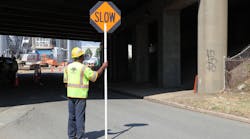Today marks the start of the 2016 National Work Zone Awareness Week, an event sponsored jointly by the Federal Highway Administration (FHWA), the American Traffic Safety Services Association (ATSSA) and the American Association of State Highway and Transportation Officials (AASHTO) to put a big crimp in the rise of fatalities in highway work zones.
This should be on the trucking industry’s radar because trucks unfortunately play a big role in this issue.
According to FHWA’s data, the heavy and civil engineering construction industries are losing up to $3.5 billion annually due to fatalities and injuries, including work zone crashes.
In 2014 alone (the year with the most recent data available), a total of 669 fatalities—the highest since 2009—occurred in highway work zones, representing an increase of more than 13% from 2013, with 116 of them highway workers, a 9% percent increase from 2013.
In addition, 30% of these fatal crashes involved one or more trucks.
It’s important to note, though, that despite this recent increase in fatalities, work zone fatalities overall are down by 23% since 1999 – the year when FHWA, ATSSA, and AASHTO kicked off their inaugural National Work Zone Awareness Week effort.
Here are a few more factoids FHWA gleaned from 2014 highway work zone crash data:
- In 2014 some 31,251 work zone injuries occurred, a 9% increase from 2013;
- In 2014, 246 large trucks and buses (235 large trucks, 11 buses) were involved in fatal crashes in work zones, a 27% increase from 2013.
- Driver and vehicle passengers accounted for 82% of work zone fatalities.
That last point may be the most important: it is vehicle drivers and their passengers who face the highest risk of death or injury in a highway work zone crash.
[Below is a video of this issue at the state level.]
And FHWA cites National Highway Traffic Safety Administration (NHTSA) driver distraction data as a big potential culprit in work zone crashes, as a driver distracted by an activity other than driving, such as eating, grooming, or using a mobile device, is up to four times more likely to be involved in a crash.
For the record, here are a few other crash-heightening statistics:
- Cell phone use increases the rate of rear-end collisions, decreases brake time by 18%, and causes a 25% increase in erratic driving.
- In 2014, distracted driving was a factor in 16% of fatal crashes in work zones, while speeding was a factor in 29%.
FHWA also noted that the most frequently occurring type of work zone crash is a rear-end collision, so paying constant attention to traffic ahead and maintaining an adequate following distance is important in avoiding them.
“Work zones are dynamic places that can change from minute to minute. The presence of trucks – including construction vehicles – flaggers and queues, combined with reduced speed limits create an environment where being alert is critical,” the agency noted. “When motorists are alert, obey traffic control devices such as signs and pavement markings, maintain the posted speed limit and pay attention to traffic patterns, everyone's safety is enhanced.”
Let’s hope folks start taking that message to heart.



